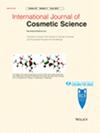In vivo efficacy of a stabilized Vitamin C-based serum at pH 6 on some ageing facial signs of women of different ages and phototypes
Abstract
Objective
To assess, clinically and instrumentally, the efficacy of a stabilized 12% Vitamin C (VC)-based serum (pH 6) on skin photoageing of women of various age and phototype.
Materials and Methods
Eighty women, with Phototypes I to VI, of various age (45–70y) living in Mauritius, participated in an open, uncontrolled study. After a two-week period of washout, they applied the Vitamin C-based serum twice a day for 2 months onto their whole face as well as a hydrating cream every evening to ensure a comparable skin hydration level in all subjects. At set time intervals (D0, D immediate, D14, D28 and D56), a local dermatologist graded eight facial signs by visual or tactile assessments, using a 0–9 structured scale. At each time interval, the facial skin was imaged by standardized technique (Colorface™) and through echography (Dermascan™) to record its thickness and density. Skin elasticity was recorded by a the Cutometer® device under a controlled suctional stress. A questionnaire was filled out by all subjects recording their self-assessments of the serum's effects and several organoleptic properties.
Results
Compared with the baseline values (D0), the skin of all subjects showed progressive and significant changes in glow, tone evenness, radiance, firmness, softness and smoothness, associated with a reduction in fine lines. Deep wrinkles, only observed on 26 subjects, were found to be reduced. Self-assessments corresponded well with both clinical and instrumental results and indicated excellent skin tolerance. Ultrasound recordings exhibited significantly thicker and denser skin at D56.
Conclusion
If certain changes in some skin facial signs (skin tone and related items, firmness, sagging…) are linked to the high concentration of VC, a complementary impact of increased skin hydration remains possible due to the glycerol present in the serum and hydrating cream. These significant performance results in vivo showed that a very acidic medium (∼pH 3) is not a prerequisite to an efficient VC cosmetic formula, as has long been accepted in the cosmetics industry. Such a low pH can fragilize the skin equilibrium over time. As second originality, the studied formula seemed to fit all phototypes.

 求助内容:
求助内容: 应助结果提醒方式:
应助结果提醒方式:


